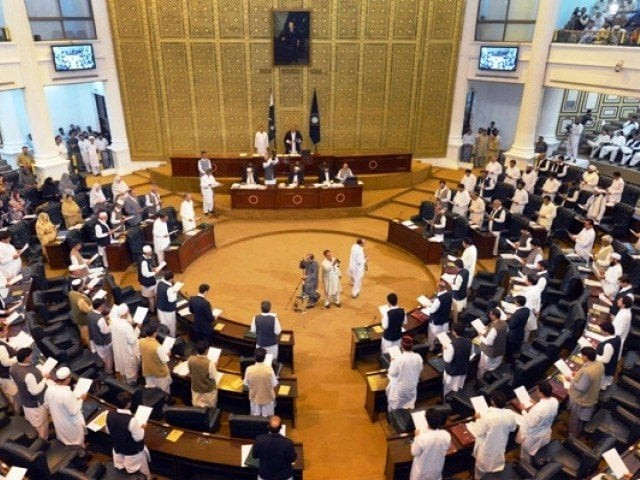Performance of all provincial assemblies records decline: Pildat
K-P assembly worked for more days than any other provincial assembly

While provincial assemblies outrank each other in different areas, each of them recorded a decline in working hours, days consumed in budget sessions and attendance of leaders of the opposition compared to the third parliamentary year, says a report released by the Pakistan Institute of Legislative Development and Transparency (Pildat) on Wednesday.
The comparative assessment shows that Khyber Pakhtunkhwa (K-P) Assembly was only convened for 60 days during the fourth parliamentary year. However, it has worked for more days than other provincial assemblies during the year.
The Balochistan Assembly met for 53 days, Punjab Assembly held only 42 sittings while the comparatively lowest number of sittings – forty-one – was held by the Sindh Assembly during the fourth parliamentary year.
“Even though the number of working hours each assembly meets for in a year is very low overall, in comparative analysis K-P Assembly was convened for most working hours at 126.05 hours during the fourth year,” says the report.
The provincial assembly of Sindh met for 111.51 working hours while the Balochistan Assembly spent a total of 91.10 working hours in sittings.
The report notes that in terms of total working hours in the fourth parliamentary year, Punjab Assembled ranked fourth for spending only 76.31 hours in sittings.
Attendance of chief ministers
During the fourth year, chief ministers of Balochistan attended the highest percentage (30%) of sittings of the provincial assembly.
Jam Kamal Khan, who had resigned as CM on October 24 last year, was replaced by Mir Abdul Quddus Bezinjo on October 29. “This is a combined attendance of both in which Jam Kamal Khan attended only 2% sittings and Mir Abdul Quddus Bezinjo attended 28% sittings,” the report says.
Meanwhile, the attendance of Punjab’s chief ministers ranks at two with 21% of sittings of the Punjab Assembly. Hamza Shehbaz, who replaced Sardar Usman Ahmed Khan Buzdar on April 16, was replaced by the incumbent premier of the province, Pervaiz Elahi on July 26.
This is a combined attendance of these three chief ministers.
As for Sindh, Chief Minister Syed Murad Ali Shah has attended only 15% sittings of the provincial assembly during the fourth parliamentary year.
Chief Minister K-P Mahmood Khan ranked fourth. He attended only 8% of the sittings of the provincial assembly during the fourth parliamentary year.
Leader of the Opposition in Sindh Assembly, Haleem Adil Sheikh, tops in the comparative analysis in terms of attendance as he attended 51.22% sittings of the assembly, followed by Leader of the Opposition in Balochistan Assembly, Malik Sikandar Khan, who attended 50.94% sittings of the Balochistan Assembly.
Akram Khan Durrani, leader of the opposition K-P Assembly, attended 18% sittings of the K-P Assembly and the lowest attendance during the fourth year is of the leader of the opposition in the Punjab Assembly— 10%.
'K-P Assembly passed most laws'
Compared to other provincial assemblies, K-P has passed 60 laws which is the highest during the fourth year. This is followed by Punjab Assembly which has passed 35 bills.
The Sindh Assembly passed 28 bills and Balochistan Assembly passed 27 bills.
The report further says that the K-P Assembly is the only assembly that recorded improved legislative activity during the fourth year and shows a 45% increase in bills passed compared to the third year when 33 bills were passed by the assembly.
In the fourth parliamentary year, K-P Assembly spent 8 days in the budget session, down from 9 days spent in the previous year, while Sindh spent 7 days in its budget session compared to 8 days of budget session in the third year.
Similarly, Balochistan Assembly has spent only 7 days during budget sessions during the third and fourth year. In the fourth parliamentary year, Punjab Assembly shows a 50% decline in days spends in budget sessions from 12 days to 6 days when compared to the third year.
During the fourth parliamentary year, the quorum was pointed out 24 times in 22 (36.67%) sittings out of 60 sittings in the provincial assembly of K-P which is the highest among four provincial assemblies.
In the Punjab Assembly, the quorum was pointed out 7 times in 5 (11.90%) sittings out of 42 sittings held in the assembly.
Meanwhile, the quorum was pointed out 4 times in 4 (7.55%) sittings out of 53 sittings held in the Balochistan Assembly during the fourth parliamentary year and out of these 4 sittings in which quorum was pointed out, only 3 (5.66%) sitting were adjourned due to lack of quorum.
However, no quorum was pointed out in the provincial assembly of Sindh during the fourth parliamentary year, says the report.



















COMMENTS
Comments are moderated and generally will be posted if they are on-topic and not abusive.
For more information, please see our Comments FAQ